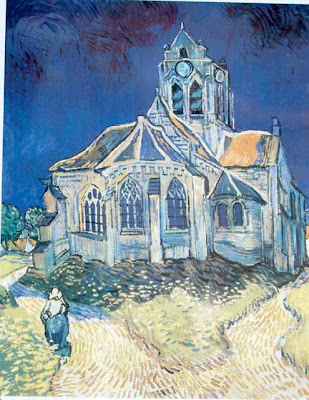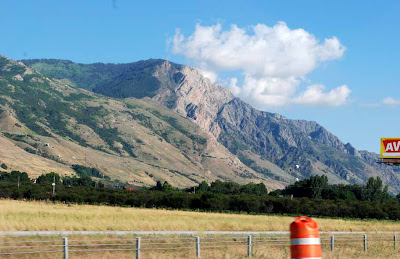Fields in Auvers
More than 70 paintings in less than 90 days. It would be an incredible feat for any artist. Vincent Van Gogh did just that from May to July 1890. He spent the last three months of his life in a quiet town not far from Paris called Auvers-sur-Oise. Intrigued by the light, bright colors, and thatched roofs in Auvers, Van Gogh was eager to return to health and painting. Vincent created some amazing artwork during this brief period, yet, was not able to lay his mental troubles aside. At the age of 37, Vincent shot himself, and eventually died in Auvers. It was a tragic end.
Place where Van Gogh lived in Auvers-sur-Oise.
Van Gogh rented a room from the Ravoux family in Auvers. He even painted the young Adeline Ravoux on more than one occasion. His room has been preserved, and is open for tourists. After watching a brief presentation, you are allowed to go upstairs to Vincent's room. You can look out the small window and imagine him looking out at the view. He did not paint in this room, but rather painted on site throughout the town. Out of respect, photography of the room is discouraged.
The town hall building Van Gogh painted in Auvers.
You can take a self-guided walking tour through the town, and see the areas where Vincent Van Gogh painted. There are plaques at the various sites that contain images of his paintings. It was actually pretty exciting to visit these locations after having viewed some of Van Gogh's paintings in the Musee d'Orsay.
Plaque featuring Van Gogh's painting: "Auvers Town Hall on 14 July 1890"
I visited Auvers in May, and found golden fields, and colorful iris in bloom. It was warm, and bright, and I could see why this place appealed to artists.
Iris blooming in Auvers.
One of my favorite stops was the church that Van Gogh painted. It's angular, gothic construction begs the observer to pick up a pencil and sketch!
Church in Auvers.
Sign featuring Van Gogh's painting of "The Church at Auvers."
While in Auvers, Vincent painted Marguerite Gachet, the daughter of Dr. Gachet. Dr. Gachet himself was an amateur artist and acquainted with several of Van Gogh's contemporaries. While some say that Van Gogh was under the care of Dr. Gachet in Auvers, others indicate there was not a patient/doctor relationship between the two. While Vincent certainly knew Dr. Gachet, and painted him, it is unknown how much medical advice Dr. Gachet gave Van Gogh. Gachet did not practice in Auvers, and was possibly more interested in Vincent as an artist. Van Gogh himself seemed skeptical of Gachet's ability to render him any assistance. He wrote in a letter to Theo dated May 20, 1890, "I have seen Dr. Gachet, who made the impression on me of being rather eccentric, but his experience as a doctor must keep him balanced while fighting the same nervous trouble from which he certainly seems to me to be suffering at least as seriously as I."
Marguerite Gachet in her Garden - Musee d'Orsay, Paris
After seeing the sites in Auvers, wander over to the small cemetery. Vincent Van Gogh is buried here. Although Theo died shortly after Vincent, he was originally buried in Holland. Theo's widow, Johanna Van Gogh-Bonger, later had Theo moved to Auvers to be buried next to Vincent.
Cemetery in Auvers-sur-Oise
Graves of Vincent and Theodore Van Gogh, Auvers-sur-Oise, France
Vincent Van Gogh was born in Holland on March 30, 1853. He painted in Holland, and eventually moved to France, where he was influenced by Impressionist painters such as Pissarro, Gauguin, and Monet. After several tumultuous years in Paris, Arles, and Saint Remy (in an asylum), Vincent moved to Auvers. He arrived in May of 1890, shot himself on July 27, and died on July 29 with his brother Theo at his side. It is reported that Van Gogh sold only one painting during his brief career. Due in no small part to the commitment of his sister-in-law, Johanna Van Gogh-Bonger, Vincent's paintings and therefore, his artistic legacy, were preserved.
"Still Life: Japanese Vase with Roses and Anenomes"
painted at Auvers, now in the Musee d'Orsay in Paris.
After seeing many of Van Gogh's paintings in Paris, I have a new respect for this wonderful artist. It is one thing to see a photo or reproduction of his paintings, and another experience completely to see the thick paint and those brush strokes in person.
Texture and color from "Marguerite Gachet in her Garden"
Happy Birthday, Vincent! I hope you are finally at rest.
Street in Auvers-sur-Oise
If you go: Today, Auvers is still quiet, and, quite honestly, not the easiest side trip. If you decide to venture here, be warned that direct trains between Paris and Auvers are limited. We took a train to Pontoise, and then took a bus to Auvers. Connecting with the return bus was not as simple, and we ended up with a very expensive cab fare back to the train station in Pontoise. That being said, you can find plenty of information on the internet about train schedules between Paris and Auvers. Had we wanted to travel at the hours those trains were available, it may have been simpler. Also, I traveled to Auvers in 2008, so check for current information!













































